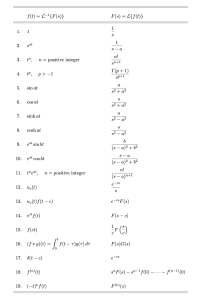Section 4.2 Use Laplace transformation to solve the differential equations
Objective:
1. Definition of inverse of Laplace transform
2. Find the inverse of Laplace transforms.
3. Understand how Laplace transformations are used to solve differential equations.
Again, our goal is to solve ODE questions that cannot be solved before. This will involved more new functions that are not continuous. At this section, we are going to use Laplace transform to solve ODE that we knew how to solve, so that we learn the principal of the problem solving process. Later, we will solve the real ODE with discontinuous functions. Recall from calculus I, we can integrate a function and then take the derivative of the integrated function, we get back to the same function. This is an inverse process. The Laplace transformation is also a process that has an inverse process.
Definition: Let [latex]f(t)[/latex] be a continuous function with [latex]L\{f(t)\}=F(s)[/latex], then [latex]f(t)[/latex] is called the inverse Laplace transform of [latex]F(s)[/latex], i.e. [latex]f(t)=L^{-1}\{F(s)\}[/latex].
Here is the table for Laplace transform and the inverse Laplace transform.
Example 1: Find inverse Laplace Transform of [latex]\frac{4}{(s-1)^{3}}[/latex].
Exercise 1: Find inverse Laplace Transform of [latex]\frac{5}{(s-4)^{6}}[/latex].
Example 2: Find inverse Laplace Transform of [latex]\frac{3}{s^{2}-s-2}[/latex].
Exercise 2: Find inverse Laplace Transform of [latex]\frac{5}{s^{2}+2s-8}[/latex].
Example 3: Find inverse Laplace Transform of [latex]\frac{s-1}{s^{2}+4s+6}[/latex].
Exercise 3: Find inverse Laplace Transform of [latex]\frac{s+3}{s^{2}-2s+5}[/latex].
Example 4: Find inverse Laplace Transform of [latex]\frac{4s^{2}-s+10}{(s+1)(s^{2}+9)}[/latex].
Exercise 4: Find inverse Laplace Transform of [latex]\frac{s^{2}+3s}{(s+2)(s^{2}+4)}[/latex].
We are almost ready to use the Laplace transform to solve an ODE. We need one more theorem.
Theorem: Suppose that [latex]f[/latex] is a function for which the following hold:
(1) [latex]f[/latex] is continuous and [latex]f'[/latex] is piecewise continuous on [latex][0,b][/latex] for all [latex]b \gt 0[/latex].
(2) [latex]|f(t)|\leq Ke^{at}[/latex] when [latex]t\geq M[/latex],for constants [latex]a,K,M,[/latex] with [latex]K,M \gt 0[/latex]. Then the Laplace Transform of [latex]f'[/latex] exists for [latex]s \gt a[/latex], with
\[L\{f'(t)\}=sL\{f(t)\}-f(0).\]
Corollary:Suppose that [latex]f[/latex] is a function for which the following hold:
(1) [latex]f[/latex], [latex]f'[/latex],...,[latex]f^{(n-1)}[/latex] are continuous and [latex]f^{(n)}[/latex] is piecewise continuous on [latex][0,b][/latex] for all [latex]b \gt 0[/latex].
(2) [latex]|f(t)|\leq Ke^{at}[/latex], [latex]|f'(t)|\leq Ke^{at}[/latex], ..., [latex]|f^{(n-1)}(t)|\leq Ke^{at}[/latex]
when [latex]t\geq M[/latex],for constants [latex]a,K,M,[/latex] with [latex]K,M \gt 0[/latex]. Then the Laplace Transform of [latex]f^{(n)}[/latex] exists for [latex]s \gt a[/latex], with
\[ L\{f^{(n)}(t)\}=s^{n}L\{f(t)\}-s^{n-1}f(0)-s^{n-2}f'(0)-....-sf^{(n-2)}-f^{(n-1)}(0).\]
For example, when [latex]n=3[/latex],
$$L\{f^{(3)}(t)\} =s^{3}L\{f(t)\}-s^{2}f(0)-sf'(0)-f^{''}(0). $$
Example 5: Use Laplace Transform to solve the IVP. [latex]y''-y'-6y=0[/latex], [latex]y(0)=1[/latex], [latex]y'(0)=-1[/latex].
Exercise 5: Use Laplace Transform to solve the IVP. [latex]y''-2y'-3y=0[/latex], [latex]y(0)=1[/latex], [latex]y'(0)=1[/latex].
Group Work
1. Use Laplace Transform to solve the IVP. [latex]y''-2y'+2y=0[/latex], [latex]y(0)=0[/latex] [latex]y'(0)=1[/latex].
2. Use Laplace Transform to solve the IVP. [latex]y''-2y'+4y=0[/latex], [latex]y(0)=2[/latex], [latex]y'(0)=0[/latex].
3. Use Laplace Transform to solve the IVP. [latex]y''+2y'+5y=0[/latex], [latex]y(0)=2[/latex],[latex]y'(0)=1[/latex].

